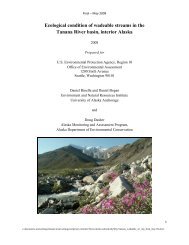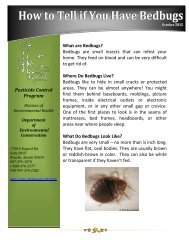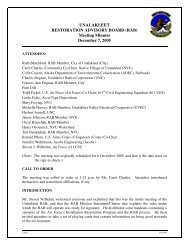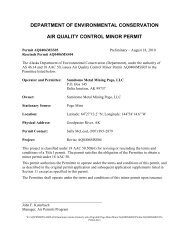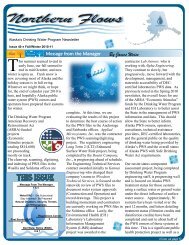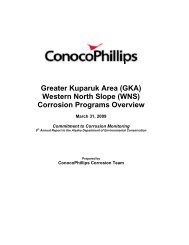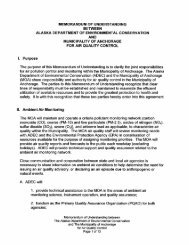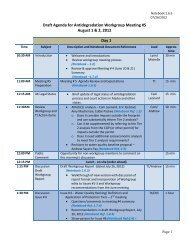2012 Ocean Ranger Guidebook Revision 3-7-12 - Alaska ...
2012 Ocean Ranger Guidebook Revision 3-7-12 - Alaska ...
2012 Ocean Ranger Guidebook Revision 3-7-12 - Alaska ...
You also want an ePaper? Increase the reach of your titles
YUMPU automatically turns print PDFs into web optimized ePapers that Google loves.
<strong>20<strong>12</strong></strong> <strong>Ocean</strong> <strong>Ranger</strong> <strong>Guidebook</strong> 3-7-<strong>12</strong><br />
Section 2: Non-Hazardous Wastes<br />
General background:<br />
Solid waste offloads have been part of the ADEC Cruiseship Program since the start of<br />
the program. Pollution by disposing of plastics and other prohibited wastes into <strong>Alaska</strong>n waters<br />
has been prohibited for years. Since 2001 ship operators have been required to submit waste<br />
offloading plans to ADEC. This initial concern was a reaction to past activities by a few<br />
cruiseship operators. Today almost all documented cases of waste dumping overboard have<br />
been accidental or from passenger activities and has been limited in size. Cruise ships have<br />
implemented extensive waste minimizing (such as recycling), sorting, and storage procedures.<br />
Common practices often include:<br />
Presorting (by the passengers or crew) of garbage in dedicated collecting bins. For<br />
example glass, food, metals (tin), plastics bottles.<br />
Collection of the garbage to sorting rooms<br />
Handling / storage of the garbage waste stream with a focus on reduction and re-use<br />
(on shore recycling) and removal of non-recyclable items and plastics/synthetics.<br />
Processing of the waste streams for storage, offload, or incineration of the waste.<br />
Waste is sorted and checked by dedicated crew members. Food waste is pulped and<br />
discharged outside <strong>Alaska</strong> or dewatered and incinerated. Paper, cardboard (that is not<br />
recycled), cartons, and other waste is incinerated by the onboard incinerator. Most case<br />
the options used onboard are vessel specific and depend on itinerary, company policies,<br />
and equipment available.<br />
Most garbage and hazardous waste is offloaded in Canada or Seattle. The offloading<br />
plans may include information on this.<br />
All cruise ships must have a Nonhazardous Solid Waste Offloading Plan as required in 18<br />
AAC 69.035. The NSWOP must describe:<br />
1. an estimate of the volume of each waste type that the owner or operator anticipates<br />
offloading in this state or disposing into the marine waters of the state;<br />
2. the proposed offloading or disposal method;<br />
3. the name and address of each contractor to be used for offloading in this state or disposing<br />
into marine waters of the state; and<br />
4. the harbors, landfills, or other offloading or disposal facilities in the state proposed to be<br />
used by the owner or operator or agent.<br />
Ships can deviate from this plan, but must report deviations by November 15 th . It is<br />
recommended to become familiar with the garbage logs, and waste offload plan if onboard for<br />
a voyage. These plans vary by company and sometimes by ship.<br />
94






